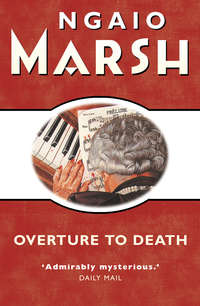
Полная версия
Death on the Air: and other stories
But ‘on the afternoon in question,’ all this, as lady crime novelists used to say, ‘lay in the future.’ The fire had burnt clear and sent leaping patterns up the walls of my London flat when I turned on the light, opened an exercise book, sharpened my pencil, and began to write. There he was, waiting quietly in the background ready to make his entrance at Chapter IV, page 58, in the first edition.
I had company. It became necessary to give my visitor a name.
Earlier in that week I had visited Dulwich College. This is an English public school, which in any other country would mean a private school. It was founded and very richly endowed by a famous actor in the days of the first Elizabeth. It possesses a splendid picture gallery and a fabulous collection of relics from the Shakespearean-Marlovian theatre: enthralling to me who has a passion for that scene.
My father was an old boy of Dulwich College – an ‘old Alleynian’, as it is called, the name of the Elizabethan actor being Alleyn.
Detective-Inspector Alleyn, CID? Yes.
His first name was in doubt for some time, but another visit, this time to friends in the Highlands of Scotland, had familiarized me with some resoundingly-named characters, among them one Roderick (or Rory) MacDonald.
Roderick Alleyn, Detective-Inspector, CID?
Yes.
The name, by the way, is pronounced ‘Allen’.
PORTRAIT OF TROY

Troy made her entrance with the sixth of the books about Alleyn. In those days, I still painted quite a lot and quite seriously, and was inclined to look upon everything I saw in terms of possible subject matter.
On a voyage out to New Zealand from England, we called at Suva. The day was overcast, still and sultry. The kind of day when sounds have an uncanny clarity, and colour an added sharpness and intensity. The wharf at Suva, as seen from the boat-deck of the Niagara, was remarkable in these respects: the acid green of a bale of bananas packed in their own leaves; the tall Fijian with a mop of hair dyed screaming magenta, this colour repeated in the sari of an Indian woman; the slap of bare feet on wet boards and the deep voices that sounded as if they were projected through pipes. All these elements made their impressions, and I felt a great itch for a paint brush between my fingers.
The ship drew away, the wharf receded, and I was left with an unattempted, non-existent picture that is as vivid today as it was then.
I don’t think it is overdoing it to say that when I began Artists in Crime, it was this feeling of unfulfilment that led me to put another painter on another boat deck making a sketch of the wharf at Suva and that she made a much better job of it than I ever would have done.
This was Troy. It was in this setting that she and Alleyn first met.
I have always tried to keep the settings of my books as far as possible within the confines of my own experience. Having found Troy and decided that Alleyn was to find her, too, the rest of the book developed in the milieu of a painters’ community. It was written before capital punishment was abolished in Great Britain, and Troy shared my own repugnance for that terrible practice: I had talked with a detective-inspector and learnt that there were more men in the force who were for abolition than was commonly supposed. I knew Alleyn would be one of them. He would sense that the shadow of the death penalty lay between himself and Troy. It was not until the end of the next book, Death in a White Tie, that they came finally together. In Death and the Dancing Footman, they are already married.
My London agent, I remember, was a bit dubious about marrying Alleyn off. There is a school of thought that considers love interest, where the investigating character is involved, should be kept off stage in detective fiction or at least handled in a rather gingerly fashion and got rid of with alacrity. Conan Doyle seems to have taken this view.
‘To Sherlock Holmes she is always the woman’, he begins, writing of Irene Adler. But after a couple of sentences expressive of romantic attachment, he knocks that idea sideways by stating that, as far as Holmes was concerned, all emotions (sexual attraction in particular) were ‘abhorrent to his cold, precise, but admirably balanced mind’.
So much for Miss Adler.
An exception to the negative attitude appears in Bentley’s classic Trent’s Last Case, where the devotion of Trent for one of the suspects is a basic ingredient of the investigation. Dorothy L Sayers, however, turns the whole thing inside out by herself regrettably falling in love with her own creation and making rather an ass of both of them in the process.
Troy came along at a time when thoroughly nice girls were often called Dulcie, Edith, Cecily, Mona, Madeleine. Even, alas, Gladys. I wanted her to have a plain, rather down-to-earth first name and thought of Agatha – not because of Christie – and a rather odd surname that went well with it, so she became Agatha Troy and always signed her pictures ‘Troy’ and was so addressed by everyone. Death in a White Tie might have been called Siege of Troy.
Her painting is far from academic but not always non-figurative. One of its most distinguished characteristics is a very subtle sense of movement brought about by the interrelationships of form and line. Her greatest regret is that she never painted the portrait of Isabella Sommita, which was commissioned in the book I am at present writing. The diva was to have been portrayed with her mouth wide open, letting fly with her celebrated A above high C. It is questionable whether she would have been pleased with the result. It would have been called Top Note.
Troy and Alleyn suit each other. Neither impinges upon the other’s work without being asked, with the result that in Troy’s case she does ask pretty often, sometimes gets argumentative and uptight over the answer and almost always ends up by following the suggestion. She misses Alleyn very much when they are separated. This is often the case, given the nature of their work, and on such occasions each feels incomplete and they write to each other like lovers.
Perhaps it is advisable, on grounds of credibility, not to make too much of the number of times coincidence mixes Troy up in her husband’s cases: a situation that he embraces with mixed feelings. She is a reticent character and as sensitive as a sea urchin, but she learns to assume and even feel a certain detachment.
‘After all,’ she has said to herself, ‘I married him and I would be a very boring wife if I spent half my time wincing and showing sensitive.’
I like Troy. When I am writing about her, I can see her with her shortish dark hair, thin face and hands. She’s absentminded, shy and funny, and she can paint like nobody’s business. I’m always glad when other people like her, too.
Конец ознакомительного фрагмента.
Текст предоставлен ООО «ЛитРес».
Прочитайте эту книгу целиком, купив полную легальную версию на ЛитРес.
Безопасно оплатить книгу можно банковской картой Visa, MasterCard, Maestro, со счета мобильного телефона, с платежного терминала, в салоне МТС или Связной, через PayPal, WebMoney, Яндекс.Деньги, QIWI Кошелек, бонусными картами или другим удобным Вам способом.










